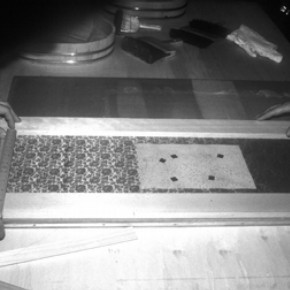Conservation Journal
Summer 2002 Issue 41
A Japanese scroll painting conservation course
Course run by the Institute of Paper Conservation and V&A Paper Conservation Studio.
Introduction
Two years ago, I was asked to repair a Japanese scroll painting. I knew that my theoretical knowledge of the skills, tools and materials in this area of conservation was superficial and my practical knowledge virtually nonexistent. I needed some tuition. Having missed previous courses organised by ICCROM and the British Museum, I asked The Institute of Paper Conservation (IPC) if they could do something similar. Pauline Webber (representing IPC) said she thought the V&A might host the course, and Philip Meredith (Head Conservator, Far Eastern Conservation Centre, National Museum of Ethnology, Leiden, Netherlands) was keen to tutor a small group of experienced conservators.
The Course
In February 2002, 10 conservators from the UK, Italy, Portugal, Switzerland, Sweden, USA and the Netherlands met at the V&A. Pauline and Philip, with the help of colleagues Merryl Huxtable and Simon Fleury, had transformed the Mounters’ studio into an ideal tutorial space, with ample space and light, together with the Department’s specialist tools, materials, and audio-visual equipment.

Figure 1. Squaring up silk mount on a newly mounted Japanese scroll. (click image for larger version)
Philip’s course had a good balance of demonstrations and practicals. I now have a sense of the subtleties of scroll mounting: how the qualities of the different materials are reconciled by the careful choice of papers and how the consistency of the starch paste adhesive used to join them is tailored to each material; how the various different tools are used and how common structural damage can be repaired.
During the course we also looked at slides and films on related subjects, which revived memories of visits to paper-making villages in Japan some years ago, and helped to make sense of the miscellaneous information I still had from that time. The range of tools and papers I acquired on that trip have now come into their own, with my new confidence to choose correctly.
The other very useful aspect of the course was the handling, display and storage of scrolls. Simon Fleury explained about storage boxes, and we practised the precise techniques of unpacking and re-rolling scrolls from their boxes and hanging them up.
Conclusion
I found Philip Meredith a most inspiring teacher: his skills and knowledge are obviously outstanding. We were extremely lucky to have the run of the studio at the V&A, with Pauline’s extensive knowledge and other staff to make everything go smoothly. The presence of a curator from the Far Eastern department, with objects from the collection to handle and discuss, added to this valuable experience. Judging by the close attention paid by the other people on the course, they got a lot out of it too. For me, there was also the pleasure of working with former colleagues again and reminiscing about my formative years of employment at the V&A in the 1980s.
Acknowledgements
Sponsorship was gratefully received from Japan 2001 and the work of the IPC Office and Meetings Organiser, Sabina Pugh, is much appreciated.
Summer 2002 Issue 41
- Editorial
- Tiaras - Mount making and installation
- Sharing museum skills
- Training matters: My experience in the painting conservation section
- Developing a collaborative approach to the conservation of lacquer
- Preservation of the Satyajit Ray paper archive: Fieldwork - January 2002
- A Japanese scroll painting conservation course
- A review of adhesives today – Exploring current options and application techniques
- The observed object: the distance between the studio and the gallery
- The importance of being less earnest: Communicating conservation
- Printer friendly version